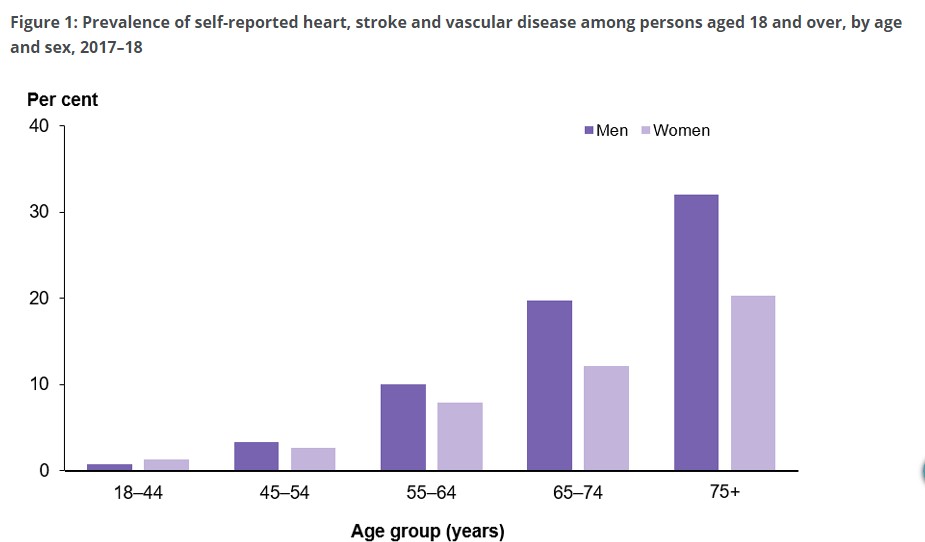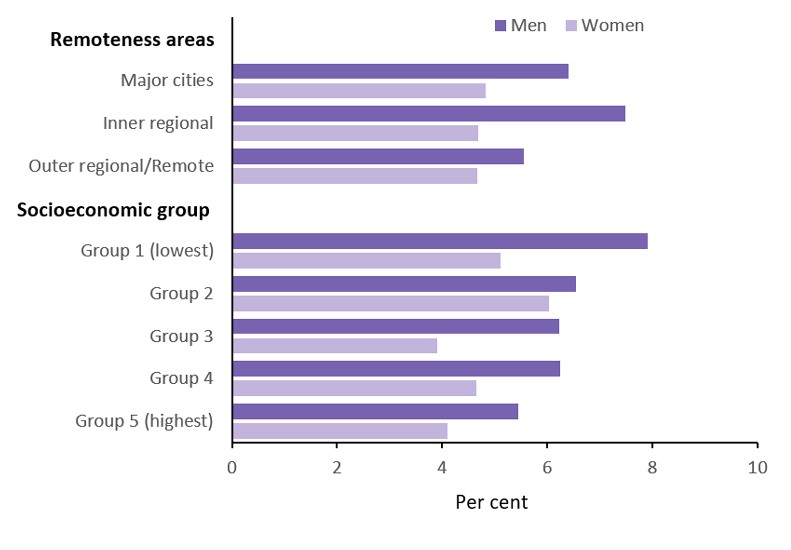Social, Behavioural and Cultural Factors in Public Health
Social Determinants of Health
Introduction
Heart diseases have become a very common phenomenon in the current scenario which is affecting the population of the entire world. The rate of heart disease is increasing at a faster rate in the regions of Australia especially in the rural regions. Men become the victim of heart disease more than children and women. The study shows that the young male population of the rural region of Australia gets more affected by heart diseases due to the overwork and the tension. This study is trying to focus on the rural groups of Australia and the effect of heart diseases on them. This study further focuses on the issue that the rural people of Australia face and the burden of the diseases on them. The deaths from cardiovascular disease (CVD) are rapidly increasing among the populations of rural Australia and this is highlighted in the paper. The social determinants of health-related problems are discussed as well.
Section 1: Social determinants of Heart disease
Burden of heart disease in Rural Australian people
An increasing rate of CVD is seen to be present in male adults than female adults in the remote and rural areas than in metropolitan areas. According to the Australian Institute of Health of Welfare (AIHW), the percentage is 6.5 for men whereas the percentage for the female population is only 4.8. The rate is increasing due to the increasing smoking rate within the local and regional people of Australia. The admission in the hospital is more due to the heart attacks in the rural regions of Australia (Ruralhealth, 2017). The people who live in the most remote places in Australia have a low rate of mortality and the quality of the survival of those people are low as well. Aboriginal groups of people become the victim of heart disease 70% more and get admitted to the hospitals than the non-indigenous population of Australia.

Figure 1 Prevalence of self-reported heart, stroke and vascular disease among persons aged 18 and over, by age and sex, 2017–18
(AIHW, 2019)
The issues related to the increasing heart disease rate implies the low quality of survival among the rural and tribal people of Australia. This is due to the reason that the healthcare service of Australia is very poor and the chance of getting a heart attack is almost 70%. The professionals in the field of healthcare services are not qualified enough and very few in number to give the proper treatment to the sufferers (Alston, Allender, Peterson, Jacobs & Nichols, 2017). The services offered are very costly and thus cannot be availed by the regional and tribal people of the remote regions of Australia. The level of earning or the income level is not high for the rural people along with the low rate of employment and education in the remote regions of Australia. These people also face issues in availing the nutritious healthy food as well as the chances of preventing diseases due to which the chances of heart diseases and obesity increase among the rural people which they do not usually have the affordability to prevent.

Figure- 2 Prevalence of self-reported heart, stroke and vascular disease, among persons aged 18 and over, by remoteness and socioeconomic group, 2017–18
(AIHW, 2019)
Role of social determinants in explaining the burden of heart diseases
The socio-economic variables or status is considered as the most significant part of the social determinant of healthcare services. The rural region of Australia is defined with a very high rate of CVD than the population living in the cities metropolitan areas. The level of healthcare services is still very low in these regions even after the wealth of the country is increasing. The socio-economic status is thus considered as the most appropriate determinant to define the services of the health care industries (Kinsman, Tham, Symons, Jones, Campbell & Allenby, 2017). The people living in the city areas of Australia will be more adaptive to the services and methods to prevent CVD and other heart diseases than the rural people of Australia. The impact of different social aspects in healthcare services is huge and can be used to reduce the CDVD issue in the people of Australia. Imbalance in social factors is the main reason behind the increasing rate of health diseases among the rural people of Australia than the other metropolitan people of the country.
Mostly the Aboriginal community of Australia faces the low level of the effects of social determinants in their health. The effect of the various socio-economic factors are very low for these people as they have low levels of income and the educational qualification is also poor. The whole system of healthcare services differs from the region of Australia and this will generate inequalities in the health of the people of the different regions of Australia. CVD will increase with the social determinants absent in the rural people of Australia. The life expectancy of the regional people of Australia will be increased only if the health services offered are improved with the improvement in the food habit of having nutritious food and the low rate of communicable diseases.
Section 2: An intervention to address social determinants of Heart disease
Public health intervention
The level of heart disease can be lower among the regional and rural people of Australia only after the execution of proper public health intervention within the society and communities. This service or intervention of public health will be helpful to lower the impact of CVD among all the Aboriginal people of Australia than the people of metropolitan cities. The intervention of public health will include the practitioners which will be helpful to increase the level of quality of the health in the people. The intervention activities for preventing the heart disease of the rural people of Australia must consist of the exercise program, Cardiac rehabilitation, and complete community intervention (Frohmader, Lin & Chaboyer, 2018). However, proper screening and changes to be made in the physical activity and dietary behavior must be carried out as a primary intervention to prevent the occurrence of this disease. On the other hand, as secondary prevention of the CVD, exercise as well as the cardiac rehabilitation program should be carried out in the rural areas of Australia. This would help in improving in increasing the quality of life and proper cardiac functioning. Rural people of Australia have the workforce which is not effective and the mixture of some ineffective workforce increases the level of the heart diseases in them. The intervention of the right workforce in the healthcare services will improve the level of quality of the rural people of Australia. The lack of knowledge and education among healthcare professionals is responsible for the increasing rate of health diseases within rural Australian people.
The prevention of CVD and other heart diseases will be prevented with the help of the illness management program but the workforce in the health department has to be well prepared for reducing the chance of heart diseases among the people of Australia. The management of chronic diseases will be prevented with the help of providing incentives to the health care workforce (Redfern, Figtree, Chow, Jennings, Briffa, Gallagher & Foreman, 2020). The strategies have to be changed for making the workforce of the healthcare services of rural Australia effective to prevent the CVD workforces. The proper training and educational programs have to be discussed and awareness must be spread about CVD to the rural people in order to make them aware of the types of preventive measures they need for reducing CVD among both male and female rural populations of Australia.
Involvement of other sectors
In order to prevent the occurrence of heart disease or CVD among the rural populations of Australia besides health sectors, the other sectors such as educational and local government should be involved in reducing the rate of occurrence of CVD (Kreatsoulas & Anand, 2010). The main reason for involving the educational sector in the intervention process is that rural people lack the proper knowledge regarding the CVD disease and for that reason, gaining knowledge about the disease and the processes by which their disease will be overcome is necessary. The educational sector would be useful for rural people in Australia as it will aid in educating the people about several things such as dietary information and what nutritious diet must be taken by them and what exercise they should perform to prevent the diseases in them.
Patients from rural areas must be given information about consuming the specific varieties of fruits and vegetables which will give them the required vitamin and protein to their body to make them strong and healthy. The whole grain is beneficial for them to change the structure of the body of the people who do not get any nutrition that is needed by the body. The people have to be active in the physical work to avoid suffering from these diseases and this can be possible only if the proper educational knowledge is provided to them (Alston, Peterson, Jacobs, Allender & Nichols, 2016). Local government can be of great help in this scenario to spread awareness among the rural people of Australia. The program like the Heart Foundation Walking program must be implemented by the local government of Australia so that the awareness can be spread among the people of Australia. .The government must develop an open space or ground area within the cities for accommodation all ages for walking and doing exercises so that the rural people of Australia become free from heart diseases.
Conclusion
The study is based on the health of the rural people of Australia and their poor condition by having a great level of heart-related diseases. This paper has shown that the rise in the rate of CVD is due to the reason that these rural people of Australia having a very low level of income and are unable to spend the amount in healthy eating and exercising. The prevention programs have to be taken in such a manner that the healthcare services have to be updated which will be useful for rural people of Australia. The social determinants of the healthcare sector are thus very important to plays the role of improving the health services of the people of Australia.
References
AIHW. (2019). Cardiovascular disease. AIHW. Retrieved on 2020 from https://www.aihw.gov.au/reports/heart-stroke-vascular-disease/cardiovascular-health-compendium/contents/how-many-australians-have-cardiovascular-disease
Alston, L. V., Peterson, K. L., Jacobs, J. P., Allender, S., & Nichols, M. (2016). A systematic review of published interventions for primary and secondary prevention of ischaemic heart disease (IHD) in rural populations of Australia. BMC public health, 16(1), 895.
Alston, L., Allender, S., Peterson, K., Jacobs, J., & Nichols, M. (2017). Rural inequalities in the Australian burden of ischaemic heart disease: a systematic review. Heart, Lung and Circulation, 26(2), 122-133.
Alston, L., Allender, S., Peterson, K., Jacobs, J., & Nichols, M. (2017). Rural inequalities in the Australian burden of ischaemic heart disease: a systematic review. Heart, Lung and Circulation, 26(2), 122-133.
Frohmader, T. J., Lin, F., & Chaboyer, W. P. (2018). Structures, processes and outcomes of the Aussie Heart Guide Program: A nurse mentor supported, home based cardiac rehabilitation program for rural patients with acute coronary syndrome. Australian Critical Care, 31(2), 93-100.
Kinsman, L., Tham, R., Symons, J., Jones, M., Campbell, S., & Allenby, A. (2017). Prevention of cardiovascular disease in rural Australian primary care: an exploratory study of the perspectives of clinicians and high-risk men. Australian journal of primary health, 22(6), 510-516.
Kreatsoulas, C., & Anand, S. S. (2010). The impact of social determinants on cardiovascular disease. Canadian Journal of Cardiology, 26, 8C-13C.
Redfern, J., Figtree, G., Chow, C., Jennings, G., Briffa, T., Gallagher, R., & Foreman, R. (2020). Cardiac Rehabilitation and Secondary Prevention Roundtable: Australian Implementation and Research Priorities. Heart, Lung and Circulation, 29(3), 319-323.
Ruralhealth.org.au. (2017). The disproportionate burden of heart disease in rural and remote Australia. Ruralhealth. Retrieved on 2020 from https://www.ruralhealth.org.au/news/disproportionate-burden-heart-disease-rural-and-remote-australia-0


